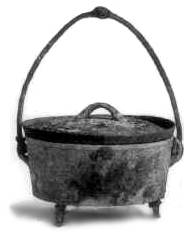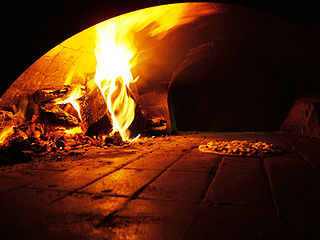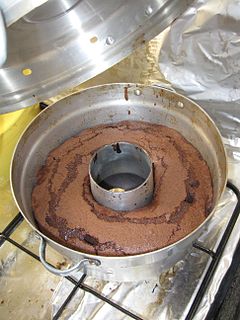
Grilling is a form of cooking that involves dry heat applied to the surface of food, commonly from above, below or from the side. Grilling usually involves a significant amount of direct, radiant heat, and tends to be used for cooking meat and vegetables quickly. Food to be grilled is cooked on a grill, using a cast iron/frying pan, or a grill pan.

Roasting is a cooking method that uses dry heat where hot air covers the food, cooking it evenly on all sides with temperatures of at least 150 °C (300 °F) from an open flame, oven, or other heat source. Roasting can enhance the flavor through caramelization and Maillard browning on the surface of the food. Roasting uses indirect, diffused heat, and is suitable for slower cooking of meat in a larger, whole piece. Meats and most root and bulb vegetables can be roasted. Any piece of meat, especially red meat, that has been cooked in this fashion is called a roast. Meats and vegetables prepared in this way are described as "roasted", e.g., roasted chicken or roasted squash.

Cookware and bakeware are types of food preparation containers, commonly found in a kitchen. Cookware comprises cooking vessels, such as saucepans and frying pans, intended for use on a stove or range cooktop. Bakeware comprises cooking vessels intended for use inside an oven. Some utensils are considered both cookware and bakeware.

Outdoor cooking differs substantially from kitchen-based cooking, the most obvious difference being lack of an easily defined kitchen area. As a result, campers and backpackers have developed a significant body of techniques and specialized equipment for preparing food in outdoors environments. Such techniques have traditionally been associated with nomadic cultures such as the Berbers of North Africa, the Arab Beduins, the Plains Indians and pioneers of North America, and have been carried down to and refined in modern times for use during recreational outdoors pursuits.

A Dutch oven is a thick-walled cooking pot with a tight-fitting lid. Dutch ovens are usually made of seasoned cast iron; however, some Dutch ovens are instead made of cast aluminium, or ceramic. Some metal varieties are enameled rather than being seasoned. Dutch ovens have been used as cooking vessels for hundreds of years. They are called casserole dishes in English-speaking countries other than the United States, and cocottes in French. They are similar to both the Japanese tetsunabe and the sač, a traditional Balkan cast-iron oven, and are related to the South African potjiekos, the Australian Bedourie oven and Spanish cazuela.

An oven is a thermally insulated chamber used for the heating, baking, or drying of a substance, and most commonly used for cooking. Kilns and furnaces are special-purpose ovens used in pottery and metalworking, respectively.

A kitchen stove, often called simply a stove or a cooker, is a kitchen appliance designed for the purpose of cooking food. Kitchen stoves rely on the application of direct heat for the cooking process and may also contain an oven, used for baking. "Cookstoves" are heated by burning wood or charcoal; "gas stoves" are heated by gas; and "electric stoves" by electricity. A stove with a built-in cooktop is also called a range.

A casserole is a large, deep pan used both in the oven and as a serving vessel. The word is also used for the food cooked and served in such a vessel, and, if so, the cookware itself is called a "casserole dish" or "casserole pan". "Casserole" should not be confused with the word cacerola, which is Spanish for "cooking pot".

A solar cooker is a device which uses the energy of direct sunlight to heat, cook or pasteurize drink and other food materials. Many solar cookers currently in use are relatively inexpensive, low-tech devices, although some are as powerful or as expensive as traditional stoves, and advanced, large-scale solar cookers can cook for hundreds of people. Because they use no fuel and cost nothing to operate, many nonprofit organizations are promoting their use worldwide in order to help reduce fuel costs and air pollution, and to slow down the deforestation and desertification caused by gathering firewood for cooking.

An earth oven, ground oven or cooking pit is one of the simplest and most ancient cooking structures. At its most basic, an earth oven is a pit in the ground used to trap heat and bake, smoke, or steam food. Earth ovens have been used in many places and cultures in the past, and the presence of such cooking pits is a key sign of human settlement often sought by archaeologists. Earth ovens remain a common tool for cooking large quantities of food where no equipment is available. They have been used in various civilizations around the world and are still commonly found in the Pacific region to date.

The following outline is provided as an overview of and topical guide to food preparation:

Cast-iron cookware is valued for its heat retention properties and can be produced and formed with a relatively low level of technology. Seasoning is used to protect bare cast iron from rust and to create a non-stick surface. Types of bare cast-iron cookware include panini presses, waffle irons, crepe makers, dutch ovens, frying pans, deep fryers, tetsubin, woks, potjies, karahi, flattop grills and griddles.

A masonry oven, colloquially known as a brick oven or stone oven, is an oven consisting of a baking chamber made of fireproof brick, concrete, stone, clay, or cob. Though traditionally wood-fired, coal-fired ovens were common in the 19th century, and modern masonry ovens are often fired with natural gas or even electricity. Modern masonry ovens are closely associated with artisanal bread and pizza, but in the past they were used for any cooking task involving baking. Masonry ovens are built by masons.

Kenkey or kormi or kokoe or dorkunu is a staple dish similar to sourdough dumpling from the Ga-inhabited regions of West Africa, usually served with pepper sauce and fried fish or soup, stew. Areas where kenkey is eaten are Ghana, eastern Côte d'Ivoire, Togo, western Benin, Guyana, and Jamaica. It is usually made from ground corn (maize), like sadza and ugali. It is also known in Jamaica as dokunoo, dokono, dokunu, blue drawers, and tie-a-leaf. In Mexico, there is a version called "Tamale". Kenkey can also be found in an area of Northern Ghana called "Tamale". In Trinidad it is called "paime" and differs in that it does not contain plantain but may include pumpkin and coconut. In the cuisine of the Caribbean, it is made with cornmeal, plantain, green banana, sweet potato or cassava, wrapped in banana leaves. The food is derived from African cooking traditions.

Pot roast is a braised beef dish made by browning a roast-sized piece of beef before slow cooking the meat in a covered dish, sometimes with vegetables, in or over liquid. Tougher cuts such as chuck steak, boneless chuck steak, short ribs and 7-bone roast are popular cuts for this technique. While the toughness of the fibers makes them unsuitable for oven roasting, slow cooking tenderizes the meat as the liquid exchanges some of its flavor with the beef. The result is tender, succulent meat and a rich liquid that lends itself to gravy.

Potbrood is bread first made by the Boer settlers of what is now South Africa. Potbrood was traditionally baked in a cast-iron pot in a pit made in the ground and lined with hot coals. Today potbrood is often made at a braai by packing charcoal or wood coals around a cooking pot.

Wonder Pot is an Israeli invention for baking on top of a gas stove rather than in an oven. It consists of three parts: an aluminium pot shaped like a Bundt pan except smooth-sided rather than fluted, a hooded cover perforated with venting holes, and a thick, round, slightly domed metal disc with a center hole that is placed between the pot and the flame.
















